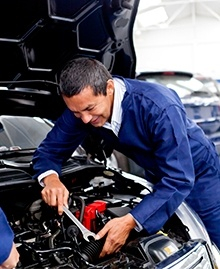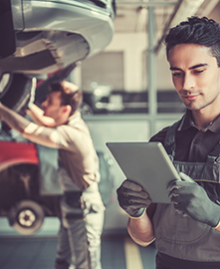Automatic gearboxes with double clutch are on the rise. Practically every car manufacturer has models that are equipped with them.
The choice for a gearbox with a double clutch is driven by the ever-stricter emission requirements; the emission of CO2 must be reduced. CO2 emissions are directly linked to fuel consumption; the less fuel consumed, the lower the emissions. All processes in a car that contribute to lower fuel consumption are welcomed by car manufacturers. This includes the automatic double-clutch transmission.
Each gear change of a car with a conventional gearbox causes the combustion engine to reduce its speed and then increase it again. This movement has an effect on fuel consumption and therefore emissions. The faster a gear change can be made, the less fuel is consumed and the less CO2 is emitted. Behold the double-clutch gearbox; a very fast gear change, allowing an almost uninterrupted transfer of torque

THE SYSTEMS FROM VALEO
As one of the largest OEM suppliers of clutches (1 in 3 European cars has a Valeo clutch on board ex-works), Valeo has also developed systems for double-clutch gearboxes. Valeo offers the Double Dry Clutch (DDC), as used in the DCT gearboxes of Hyundai and Kia, as well as the Double Wet Clutch (DWC), as used by Renault, Alpine, Nissan, Mercedes, BMW and Mini from 2015.
Valeo Service has had the DDC for Hyundai/Kia available in the independent aftermarket for some time, along with the necessary flywheels and actuator modules. The DWC is about to be introduced and will be launched very soon, along with the necessary flywheels.
HOW DOES THE VALEO DDC WORK?
The Valeo DDC is a largely purely mechanical system, operated by an electromechanical actuator. No hydraulics or complicated mechatronics are used. Due to its relatively simple construction, it can be easily installed by most workshops. However, unlike any other clutch produced by Valeo, the special tool kit is required. After removing the gearbox, the dual mass flywheel remains on the engine and the clutch module moves with the gearbox. The module can then be easily replaced with the gearbox on the workbench.
The DDC consists of a pre-assembled module, consisting of a spacer ring, with a friction plate and pressure ring on either side, which are actuated by coaxially arranged pressure groups through a coaxial pressure bearing and double control fork. The double control fork is connected to the actuator module on the side of the gearbox.
The basis of a double clutch is that both clutches are open by default and are closed by the thrust bearing. This is exactly the opposite of a conventional clutch, where the pressure group provides the clamping force and is opened by the bearing. The standard opening is also necessary, because otherwise both clutches would close in case of an emergency, which would result in major damage to the gearbox.
After fitting the new clutch module in the gearbox, it is important to adjust the actuator module to the correct position, since it adjusts itself as the clutch wears in order to always maintain correct operation. Leaving the actuator untouched would mean compromising operation. Adjustment is done with the special jig found in the tool kit.
The DDC sets offered by Valeo are complete sets with all the necessary parts: the clutch module, the co-axial thrust bearing, the bearing guide sleeve, the control forks, a special coupling for the precise shaft and all the necessary bolts. Perhaps it is good to emphasize once more that the DDC clutches are absolutely identical to the parts that Valeo supplies to Hyundai/Kia. So you get the OEM product!








